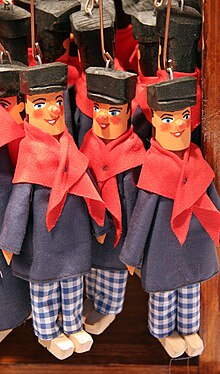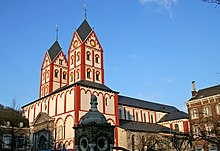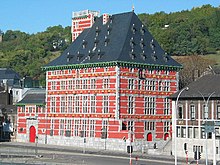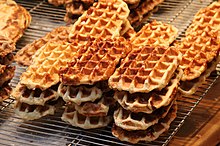Liege
Liege (in French, LiègeIn Dutch, Luik, pronounced/lœyk/(![]() listen)) is a Belgian city of 192 711 inhabitants, located in the French-speaking part of the country, near the borders with Germany and the Netherlands. It is the fifth city of the country after Brussels, Antwerp, Ghent and Charleroi, and its metropolitan area of more than 600 000 inhabitants, the third after those of Brussels and Antwerp. It is the third most populous French city in the country after Brussels and Charleroi. It is located in the valley of the river Mosa, near the eastern border of Belgium with the Netherlands and Germany, where the Mosa is located with the river Ourthe. It is in an old industrial zone, the industrial dorsal spine of Valonia. The municipality of Lieja includes the ancient villages of Angleur, Bressoux, Chênée, Glain, Grivegnée, Jupille-sur-Meuse, Rocourt and Wandre.
listen)) is a Belgian city of 192 711 inhabitants, located in the French-speaking part of the country, near the borders with Germany and the Netherlands. It is the fifth city of the country after Brussels, Antwerp, Ghent and Charleroi, and its metropolitan area of more than 600 000 inhabitants, the third after those of Brussels and Antwerp. It is the third most populous French city in the country after Brussels and Charleroi. It is located in the valley of the river Mosa, near the eastern border of Belgium with the Netherlands and Germany, where the Mosa is located with the river Ourthe. It is in an old industrial zone, the industrial dorsal spine of Valonia. The municipality of Lieja includes the ancient villages of Angleur, Bressoux, Chênée, Glain, Grivegnée, Jupille-sur-Meuse, Rocourt and Wandre.
Toponymy
Surely, the name of Liège has the same origin as the old name of Paris, Lutetia; the German form of Liège, Lüttich, suggests a relationship. Liège and Lutecia comes from Laetica, from Lugus (the supreme god of Celtic mythology), from which other names come, such as Lyon.
It is more probable that the etymological origin is Leudico, a form exposed in 718, (from the old Germanic name of leudika, which derived from Leudi which means 'people'): 'people's land or common land'.
The oldest known form is Luga, which derives from Lyge, from which it derives its Walloon name Lîdje, which derived Liège. The name was written Liége (with the acute accent) until 1946. The change in spelling with the grave accent was made to be more in line with the local pronunciation.
The city is commonly called the "Fiery City," a name that comes from the title of a roman chevaleresque (novel of chivalry) written by Henry Carton de Wiart in 1904. This novel recounts the sacking of the city by the troops of Charles the Bold in 1468.
History
Prehistory
Traces found dating back to 200,000 BCE. C. show that there were already inhabitants on the place where Liège is located since prehistoric times. These occupations were probably discontinuous.
Antiquity
A Roman building, occupied during the second and third centuries, was discovered in the heart of the city, beneath the remains of the cathedral, in St. Lambert's Square.
Middle Ages
Eight centuries of history, within a Principality Independent of the Germanic Empire, helped to forge "the Liege spirit": proud and tenacious, willingly mocking and honest, warm and welcoming.
The fate of Liège was sealed the day Lambert, Bishop of Tongeren, was assassinated there. At the beginning of the 8th century, Liège was a small town situated at the confluence of a stream, the Légia, and one of the many arms of the Meuse.
Very quickly, in fact, the pilgrims rushed to Liège, the place of Lambert's martyrdom, to the point that his successor, Hubert, decided to move the capital of the diocese there. Consequently, the village was populated by numerous monks who dragged merchants and artisans in their wake. The first bell towers appeared in his sky. Liège grew rapidly and took the step of a small, true and ecclesiastical city.
A petite bourgeoisie existed since the Early Middle Ages. However, the foundation of the city as such dates back to the year 700, after the assassination of Saint Lambert, Bishop of Maastricht. Following the event, his successor, Saint Hubert, transferred with papal approval the seat of the bishopric from Maastricht to Liège. Hubert thus became the first bishop of Liège. Liège thus became an important place of pilgrimage and gradually became a prestigious and developed city.
A part of the Merovingian and Carolingian dynasty originated from Liège, more probably from Jupille or Herstal. A statue of Charlemagne made in 1867, stands in the center of the city. In the niches of the Neo-Romanesque pedestal there are six statues representing the emperor's ancestors, originally from Liège: Bega of Cumberland, Pepin of Heristal, Charles Martel, Bertrude of Vermandois, Pepin of Landen and Pepin the Short. The first bishops of Liège are also relatives of the Carolingians.
Principality of Liège
The Principality of Liège begins when Notker of Liège was called to the episcopal throne of the city by Emperor Otto II in 972. He also received the privilege of general immunity in 980. The Bishop of Liège was then the sole owner of his lands, became prince-bishop and made his domain an ecclesiastical principality. It was the capital of the Principality of Liège from 980 to 1795 and was also one of twenty-three Good Cities.
Liège became, in the X century, the capital of a powerful and episcopal principality, thanks to the action of bishops like Éracle, Notger and Wazon. Its schools were very famous until the 12th century and seven collegiate churches were built up to that time (Saint-Pierre, Sainte-Croix, Saint-Paul, Saint-Jean, Saint-Denis, Saint-Martin, Saint-Barthélemy) as well as the cathedral, where Saint Lambert was buried, and two Benedictine abbeys, Saint-Jacques and Saint-Laurent. In addition, many churches and pieces of goldsmithing (Mosano Art) testify to the power of that time, in particular the baptismal font of the city, currently preserved in Saint-Barthélemy.
After it quickly became an industrial city, coal was mined for a long time. Jean Curtius was at this time one of the largest gunsmiths in Europe.
The Massacre of 1468
Until now, Liege has been independent but the Duchy of Burgundy conquered all the secular principalities and ecclesiastical territories until it became a single absolutist state. However, in Liège they reject the prince that Felipe III of Burgundy imposes on them and ally themselves with Louis XI of France but they lose in Montenaken and are subjected to sign a humiliating peace in 1465. Later they resist but their army is beaten again in Brustem by the son of Felipe III, Carlos the Bold, who suppressed the country legally. In response to the assassination attempt perpetrated by Franchimontois's 600 on Charles, when he was on the Bueren mountain, the city was pillaged and burned on November 3, 1468. Only a few religious monuments were saved and the &# 34;perron", a monument that symbolizes the liberties of Liege, was transferred to Bruges as a humiliation. After ten years, once Charles the Bold died, said monument was returned to Liège.
From 1468 to 1789
Liège will regain pardon and its relative independence, in 1478, as a consequence of the death of Carlos. In this way, it is again the capital that will see in the XVII century), the birth of capitalism with Jean Curtius and the arrival of the Enlightenment in the 18th century under the impulse of Bishop Francisco-Carlos de Velbrück. The intransigence of his successor, César-Constantino-Francis de Hoensbroeck will lead to the Liege revolution. The existence of the Principality of Liège ends between 1789 and 1795.
Liege Revolution
In 1789, the French Revolution and the Liege Revolution broke out simultaneously. Nicholas Bassenge was at the head of the patriots of Liège and manages to throw out the Prince-bishop who finds refuge in Trier (Germany). But quickly he is replaced on his throne by the Austrian troops who reoccupy the Principality and the Netherlands from the Habsburgs.
The restoration of the prince-bishop is not well accepted and that is why they welcomed the French troops of Charles François Dumouriez as liberators in 1792. The political and social system of the Old Regime was turned upside down, for example, in Liège universal suffrage could be voted for the first time. In 1792, they used these new rights to vote en masse for the reunion of their Principality in France. In 1793, a second restoration of the Prince-bishop took place after the French were defeated at the Battle of Neerwinden.
In June 1794, the imperial army leaves the Principality of Liège, which leads to the final exile of the last prince-bishop, Franz Antoine-Marie de Méan. In 1795, the National Convention decrees the incorporation of the Principality to the French Republic, being then Chef-lieu of the department of Ourthe.
19th and 20th centuries
On January 20, 1814, the allied troops of the Sixth Coalition, commanded by General von Bülow, took the city. In 1815 by the Congress of Vienna. The territory, like the rest of the future Belgium, came under the guardianship of the United Kingdom of the Netherlands, a period during which the University of Liège and the Royal Opera of Wallonia were created. In 1830, the Belgian revolution broke out and Liège is henceforth part of the kingdom of Belgium.
After that year, Liege dominates Belgian political life, with Charles Rogier leading the Belgian government. Liège becomes the citadel of radical liberalism. William I of the Netherlands, Jean-Jacques Dony and above all John Cockerill make Liège the first city in Europe in the Industrial Revolution. Around 1850, Cockerill's steel and metal construction complex at Seraing is the largest in the world, and Belgium is the world's second-largest economic power behind only the United Kingdom. In order to protect Liège from flooding, dikes were built on the River Ourthe and the River Meuse around the 19th century, to channel the water and create new boulevards (Avroy and Sauvenière).
The resistance of the forts of Liège in 1914 earned the city the French Legion of Honor (the first foreign city to obtain it) on August 7, 1919, the Italian war cross in 1923, the military medal for bravery of the Kingdom of Serbs, Croats and Slovenes in 1926 and the Belgian War Cross in 1940. Several exhibitions were held in the city at the beginning of the century: the universal exhibition of 1905 for the seventy-five years of Belgium, the international exhibition of 1930 for the centenary of the country (specialized in science and industry) and the 1939 water exhibition that marks the completion of the work on the Albert Canal that connects Liège to the port of Antwerp.
In 1937, the city of Liège decided to celebrate the French national holiday every July 14 in order to protest against the country's policy of neutrality against Nazi Germany and against the denunciation of the Franco-Belgian military agreement by the Belgian authorities. The French national holiday gathers more than 30,000 people every year.
In 1939 an International Exposition took place in Liège, whose main theme was water.
When the real question marches towards its denouement (1950), Paul Gruselin, Joseph Merlot and André Renard participate in the project of a separatist Walloon government that is born as a result of the serious incidents in Grace-Berleur on July 31st. The Liege socialists are again very present in Belgian politics with Jean-Joseph Merlot in the government of Théo Lefèvre and Paul-Henri Spaak between 1961 and 1965, but they force Merlot to resign in response to the vote on conservation laws from the linguistic border. Pierre Harmel is one of the Walloon Prime Ministers of the 19th century (1965 to 1966).
Merlot came to power again with Gaston Eyskens in 1968 and André Cools (after Merlot's death in a traffic accident) laid the foundations of Belgian federalism. From 1978 to 1986, the Liege steel industry was threatened with bankruptcy and caused a maximum mobilization with serious demonstrations in February and March 1982 in Brussels. Liège became the economic capital of the Walloon region and the role of Jean-Maurice Dehousse at the head of the first Walloon government was decisive.
Geography
Politics
The city of Liège, district head of the province of the same name, has the particularity of being located at the meeting point of three countries, since it is 25 kilometers south of Maastricht in the Netherlands and 40 kilometers west of Aachen (Aachen) which is in Germany. It belongs to a cross-border region, the Meuse-Rhine Euroregion, a privileged catchment area with some 3.7 million inhabitants.
This situation has a great tradition, not to mention the Roman times, this cross-border region constituted a single state since the Carolingian period. After 843, when the Empire of Charlemagne was dismembered by the Treaty of Verdun, the region formed part of Middle France, very temporarily, since in the year 962, Otto I of Germany had the great idea to restore the Christian order with the Holy Roman Empire.
Natural
The city is also located at a crossroads of three natural geographical zones: in the north is Hesbaye (160-200 m), one of the main agricultural areas of Belgium; to the east is the Land of Herve (200 to 320 m), a more undulating and raised landscape, a fruit-bearing region and to the south is Condroz (200 to 280 m), in the Ardennes where the highest point of Belgium is with 694 m, the Signal de Botrange.
The territory of the city is made up of a significant part of the floodplains of the Meuse River, which meanders for about 950 km from Langres in France to the Netherlands, where it joins the Rhine River to flow into the North Sea.
The Meuse runs through Liège in a south-west/north-east direction for 12 km fully canalised, has an artificial bypass and three canals: the Ourthe canal, a small non-navigable canal and the beginning of the Albert canal opened in 1939.
The autonomous port of Liège enjoys a privileged location, where the city is linked by water to France, Flanders and the Netherlands. The port's activity continues to grow, with more than 22 million tons handled in 2004, making it the second river port in Europe in terms of tonnage behind the port of Duisburg but ahead of the autonomous port of Paris.
Economy
It is the most important city in the Walloon Region from an economic point of view. It was for a long time a great industrial city but since the 1960s, it has suffered a decline after its factories became outdated. Today it is known, however, as the Palo Alto of Europe, since it is where the highest concentration of digital, technological and Internet-oriented services industries occurs.
It has a large number of companies dedicated to high technology such as Techspace Aero, which manufactures parts for the Airbus A380 or the Ariane 5 rocket. Also noteworthy are Amós, which manufactures optical components for telescopes, and Drytec, a manufacturer of drying rooms for compressed air. In addition, Liège has numerous electronics companies such as EVS, the world leader in real-time television idling, Gillam, AnB, Balteau, IP Trade or Dinh Telecom.
Other notable companies are the still world leader in light weapons, FN Herstal, the beer company, Jupiler, the chocolate company Galler or the water and soft drinks company, Spa and Chaudfontaine. The University of Liège also has numerous campuses, and high-tech companies such as EVS are located near it.
Demographics
As of 1 January 2018, the municipality of Liège had a total population of 197,355. The conglomerate has around 750,000 inhabitants and covers around 265 km². It brings together the old communities of: Angleur, Bressoux, Chênée, Glain, Grivegnée, Jupille, Liège, Rocourt, Wandre (also the Sclessin neighborhood of the old community of Ougrée and some streets of Ans, Saint-Nicolas and Vottem). These communities were integrated into the city of Liège in 1977, following the community merger policy. This territory covers about 69 km², with a population density of 2,755 inhabitants/km². The total for the province rises to 1,053,722 inhabitants over a territory of 3,862 km².
The communities of Seraing, Saint Nicolas, Ans, Herstal, Beyne-Heusay, Fléron, Chaudfontaine, Esneux and Flémalle are part of this urban agglomeration. The Liège agglomeration, which, unlike the urban agglomeration, can include rural areas, has about 600,000 inhabitants. The low density of this population results in a large number of undeveloped spaces close to the city center and which are of three types: hillsides, industrial areas (including former coal mining areas) and large forest areas. south of the urban agglomeration (Sart-Tilman). A comparison with other Belgian communities is possible within the list of the most populous Belgian communities.
Evolution of the population
| Year | 1803 | 1806 | 1820 | 1846 | 1865 | 1880 | 1900 | 1910 | 1920 | 1961 | 1976 | 1997 | 2002 | 2007 |
| Inhabitants | 45 496 | 46 983 | 49 962 | 75 961 | 105 903 | 123 131 | 157 760 | 167 521 | 163 298 | 153 240 | 135 347 | 189 510 | 184 259 | 190 048 |
In 1977, the community of Liège merged with other communities to form a new entity. The upper table shows the distribution of the population among the different communities. The main neighborhoods that make up the center of Liège are: Amercoeur, Avroy, Burenville, Le Carré, Cointe, Coronmeuse, Outremeuse, Pierreuse, Saint-Gilles, Saint-Laurent, Saint-Léonard, Sainte-Marguerite, Sainte-Walburge, Sclessin, Thier-à-Liège and Vennes.
Evolution
All the historical data related to the current municipality, the following graph reflects its demographic evolution, including municipalities after the merger on January 1, 1977.
| Graphic of demographic evolution of Liège between 1846 and 2019 |
 |
Education
| University | Foundation | Acronym | Type | |
|---|---|---|---|---|
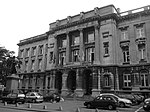 | University of Liège | 1817 | ULg | Public University of the French Community of Belgium, French-speaking |
Liège is an important center of education, with more than 93,000 young people studying in this city whose main centers are the University, two educational networks (secular and Catholic), technical and professional education, the Academy of Fine Arts, the royal music conservatory that offer a wide range of possibilities.
In recent years; Liège has become a popular destination for foreign students on the Erasmus programme, due to its university atmosphere and its favored geographical location.
Not counting the University, the largest institutions are:
- The High School of the Province of Liège with around 8000 students.
- Hemes High School with 3500 students.
- The High School of the City of Liège with 2200 students.
- The Royal Conservatory of Music.
Transportation
| Airport | IATA Code | ICAO Code | |
|---|---|---|---|
 | Liège Airport | LGG | EBLG |
It has numerous logistical advantages that give the city an important position in Europe in the transport sector. Highlights:
- The autonomous port of Liège, the second European river port.
- The station of Liège-Guillemins and the new TAV lines of Brussels towards Liege LGV 2 and Liège towards the German border LGV 3.
- A network of motorways with no toll of seven branches (E40, E42, E25, E313).
- From here you can also easily reach Brussels South Airport and Brussels-Zaventem Airport which are about 95 kilometers away, but even closer is the Maastricht Aachen Airport, just 40 km away.
- It also has a bus network of the company TEC Liège-Verviers, which covers the entire city center and the agglomeration.
Culture
Liège was the center of Mosano art in the X, XI and XII with their schools that developed techniques in parallel with the works of art such as the baptismal font of Saint-Barthélemy. In the XIII century, Juliana de Cornillon (1191-1258) was born, a strong spirituality with the origin of the beguinages, which they attracted Francis of Assisi.
In the 16th century, Érard de La Marck had a new Palace of the Prince-Bishops, Ernest of Bavaria, rebuilt, very informed about the astronomical searches of his time, supplied Johannes Kepler with a perfect astrolabe, René de Sluze was the center of the mathematical searches of the century XVII.
At the university, founded after 1830, Marcel Florkin and Zénon Bacq studied. Jean d'Outremeuse covers the legend of the four sons of Aymon, Jean Leben inscribes Liège in the French literature of the Middle Ages and Jorge Simenon, Stanislas-André Steeman and Alexis Curvers in the current one.
There are also three of the most important cultural institutions in the country such as the Royal Opera of Wallonia, the Philharmonic Orchestra of Liège and the French community and the Teatro de la Plaza as well as a radio and television production center, many cultural institutions, four cultural centers, the most important cinematographic complex in the Meuse-Rhine region and museums of international prestige.
| Date | Name in Spanish | Local name | Notes |
|---|---|---|---|
| 3.a week of March | Saint-Torè | Saint-Torè | |
| Wednesday of Saint-Torè | 4 hours skateboarding | 4 heures trottinettes | |
| April | International Film Festival | Festival international du film policier | |
| May | International Festival "Jazz à Liège" | International Festival "Jazz à Liège" | |
| June | Festival animated | BD Festival | |
| July | Festival de Música electro-rock Les Ardentes | Festival de musique électro-rock Les Ardentes | |
| July | Pueblo galo | Village gaulois | |
| 14 July | Festivals of 14 July | Fête du 14 juillet | |
| 15 August | August 15 parties in Outremeuse | Fêtes du 15 août en Outremeuse | |
| September | Reunions | Retrouvailles | |
| September | The 2008 city parade | City Parade 2008 | |
| First Saturday of October | Night of the slopes of the citadel | The Nocturne des Coteaux de la citadelle | |
| First Sunday of October | El Jogging de Lieja, 10 km | Le Jogging de Liège, 10 km | |
| October and November | The October fair | La Foire d'Octobre | |
| 1.a Week of December | San Nicolás de los estudiantes | Saint-Nicolas des étudiants | |
| December | The Village of Noël | Le Village de Noël | |
| Every Sunday morning | Batte Market | Marché de la Batte |
Religious heritage
- Notre-Dame-et-Saint-Lambert (destroyed)
- Cathédrale Saint-Paul (with the cathedral treasure museum)
- Old Abbey (Church) of Saint-Jacques (Santiago)
- Colegiata Saint-Barthélemy (with baptismal sources)
- Saint-Martin Basilica
- Colegiata Sainte-Croix
- Colegiata Saint-Denis
- Colegiata Saint-Jean
- Abbey of the Paix-Notre-Dame
- Church of Saint-Sacrement
- Notre-Dame Church of the Sacred Heart
- Church of Grand Séminaire
- Sainte-Catherine Church
- Saint-Chistophe Church
- Saint-Gérard Church
- Saint-Gilles Church
- Saint-Nicolas Church
- Saint-Pholien Church
- Saint-Remacle Church
- Saint-Servais Church
- Sainte-Véronique Church
- Saint-Vincent Church
- Chapel Girls of the Cross
- Saint-Augustin Chapel (or Bavaria)
- Liege Synagogue
- Robermont Cemetery
Civil heritage
- Palace of the Princes-Bishops of Liège
- House of Curtius
- Liege Town Hall ("La Violette")
- "The Perron"
- Classified location of the "coteaux de la citadelle"
- Bueren Mountain
- Estación de Liège-Guillemins, artwork by the Spanish architect Santiago Calatrava
- Royal Opera of Wallonia
- Liège Philharmonic
- University, downtown location and Aquarium Museum
- Old Liège Posts
- Old Liege Market
- Old Abbey Saint-Laurent
- Old church Saint-André
- Old church Saint-Antoine (and the convent of the younger brothers)
- Statue Li Tore
Museums
One of the most outstanding museums in the city is the Curtius Museum or Curtius House, which is an archeology museum. The palace in which it is located is in the Renaissance style, built between 1600 and 1610 by Jean Curtius, industrialist, wealthy Liejano and also treasurer and supplier to the armies of the King of Spain in the Spanish Netherlands, better known under the Latinized surname of Curtius and to whom Liège owed its industrialization in the 17th century.
In addition to this museum, the Museum of Weapons, the Museum of Religious Art and Mosan Art, the Ansembourg Museum, the Archéoforum, the Treasury of the Cathedral, the Museum of Modern Art and Contemporary Art, the Museum of Walloon Art stand out, the Museum of Walloon Life (Cour des Mineurs), the Aquarium and Zoology Museum, the House of Science, the House of Metallurgy, the Grétry Museum, the Tchantchès Museum and the Transport Museum.
Cinematography
The most relevant figures are undoubtedly the Dardenne brothers, filmmakers who have won the Palme d'Or on two occasions at the Cannes Film Festival for their films Rosetta (1999) and The child (2005). Also noteworthy are actresses Berthe Bovy, Marie Gillain, winner of the 1995 Golden Bear at the Berlin International Film Festival for the film L'appât, and actor Bouli Lanners. Also noteworthy is the installation in the city of a film production studio, the Wallonie Image Production (WIP).
Gastronomy
Perhaps the most characteristic food is the Liège waffle, which is made fresh from waffle irons in small shops and it is also possible to buy it pre-cooked in supermarkets. It is much smaller, sweeter and denser than Belgian waffles and has a characteristic that distinguishes it: a layer of liquid caramel that covers it, the result of a last minute addition to the dough of a syrup, giving it a distinctive flavor. Most are served without any accompaniment, although it is possible to flavor them with vanilla or cinnamon and sometimes they are garnished with fruits, creams, and chocolate.
The bouquette (a crepe), the peket (a type of gin), the jupiler (beer), the Herve cheese, the Liège syrup, the Liège salad, the Liège rabbit and the marzipan are also characteristic.
Sports
Liège has been the host city of Euro 1972 and 2000.
In terms of sporting events, the Liège-Bastogne-Liège stands out above all, one of the oldest cycling events, dating its first edition from 1892 (hence the nickname of La Doyenne -La Dean-). It is one of the five cycling events called "Monuments", along with Milan-San Remo, the Tour of Flanders, Paris-Roubaix and the Giro de Lombardy. Likewise, it is part of the Classics of the Ardennes triptych.
Twinned cities and international cooperation
The city of Liège is twinned with several cities in the world:
- Nancy (France) since 1954
- Maastricht (Netherlands) since 1955
- Aquisgrán (Germany) since 1955
- Rotterdam (Netherlands) since 1958
- Turin (Italy) since 1958
- Cologne, Germany since 1958
- Esch-sur-Alzette (Luxembourg) since 1958
- Lille (France) since 1958
- Volgograd (Russia) since 1959
- Lubumbashi (Democratic Republic of the Congo) since 1961
- Pilsen (Czech Republic) since 1965
- Porto (Portugal) since 1977
- Krakow (Poland) since 1978
- Saint-Louis (Senegal) since 1980
- Tangier (Morocco) since 2006
It is also in cooperation and friendship with:
- Quebec, Canada, since 2002.
Notable people
Contenido relacionado
India
Salta Province
Eritrea








